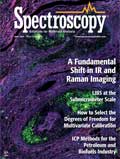How Are ICP Methods Being Used in the Petroleum and Biofuels Industry?
Inductively coupled plasma (ICP), coupled with optical emission spectroscopy (OES) and mass spectrometry (MS), has seen a lot of recent growth for the direct analysis of organic samples such as petroleum and biofuels. José-Luis Todolí of the University of Alicante in Spain talks about his work to improve the analytical figures of merit in ICP-OES and ICP-MS in these analyses.
Inductively coupled plasma (ICP) techniques, such as ICP coupled with mass spectrometry (ICP-MS) and ICPâoptical emission spectroscopy (OES), have seen a lot of growth in recent years for the direct analysis of organic samples such as petroleum and biofuels. José-Luis TodolÃ, a professor at the University of Alicante in Spain, has conducted several studies in this area, including the elemental determination of metals in bioethanol using ICP-OES, and the use of a torch integrated sample introduction system as well as ICP-MS to analyze petroleum products and biofuels. He recently spoke to us about this work and other projects involving ICP techniques that his group is focused on.
What do you consider to be the most challenging research application for ICP at the moment? Are you currently working on any projects that would address that challenge?
There are many challenging subjects within the field of ICP techniques. One of those is related to the direct analysis of organic samples. In this case, the petroleum and biofuels industry required approaches to overcome the problems associated with the introduction of organic solvents. In these cases, metals play an extremely important role and they should be accurately determined. Additional challenges include medical applications, nanoparticle analysis, and speciation among others. Although very important progress has been made in these fields, there is still a need for increased sensitivity and methods for overcoming interferences.
Alternatively, direct solid analysis is a subject of great interest and many different groups have been evaluating techniques such as laser ablation or laser-induced breakdown spectroscopy that require simpler and robust calibration procedures.
We have established a long-term collaboration with the IFP Energies Nouvelles in Lyon, France, to develop methodologies for improving ICP-OES and ICP-MS analytical figures of merit for the analysis of petroleum products and biofuels. This collaboration still continues, and currently we are focusing on the biofuel analysis in particular.
In this case, we are combining the advantages of using a micronebulizer at low liquid flow rates with the improvement in sensitivity encountered when a high-temperature spray chamber is employed. On the one hand, sensitivities are improved by an average factor of 2â10. This is extremely important for bioethanol samples because metals and metalloids concentrations are low in these kinds of samples. On the other hand, bioethanol may contain water at different levels depending on the particular sample. This may induce interference, thus leading to inaccurate results. By using the new device it has been possible to remove these interferences.
In an earlier paper (2), your group used the heated torch sample introduction system with ICP-MS to analyze petroleum products and biofuels. How does this method differ from the ICP-OES method discussed above? Which method is more challenging? Which method produces the best results?
Well, the system employed is basically the same. The most interesting point is that a small sample plug is injected into an air carrier stream. By working under this methodology, the sensitivity is independent of the sample nature. As a result, it is possible to analyze samples as varied as gasoline, diesel, biodiesel, and ethanol fuel by using a unique set of standards. Interestingly, it is not necessary to add an oxygen stream to avoid the formation of carbon deposits at the interface because air is introduced between consecutive injections.
Your research has spanned a wide range of application areas requiring various approaches to sample introduction. How did you get involved with developing new liquid sample introduction systems for ICP? What are the main challenges you and your group faced in developing these new systems?
The liquid sample introduction step still is one of the most critical steps in ICP techniques. The quality of the obtained results is often limited by the quality of the nebulizer, spray chamber, desolvation system, and so forth. Therefore, it is compulsory to design devices that are able to fulfill the plasma requirements (aerosol fineness, low solvent plasma load, and quick washing out) to enlarge the field of application of our technique. The main challenges faced by our research group were the plasma’s limited capability to accept a moderate solvent load without degradation in either its thermal properties or the signal stability.
References
- C. Sánchez, C.-P. Lienemann, and J.-L. TodolÃ, Spectrochim. Acta, Part B115, 16â22 (2016).
- R. Sánchez, C. Sánchez, J.-L. TodolÃ, C.-P. Lienemann, and J.-M. Mermet, J. Anal. At. Spectrom.29, 242 (2014).
This interview has been edited for length and clarity. To read the full interview, please visit: www.spectroscopyonline.com/how-are-icp-methods-being-used-petroleum-and-biofuels-industry

LIBS Illuminates the Hidden Health Risks of Indoor Welding and Soldering
April 23rd 2025A new dual-spectroscopy approach reveals real-time pollution threats in indoor workspaces. Chinese researchers have pioneered the use of laser-induced breakdown spectroscopy (LIBS) and aerosol mass spectrometry to uncover and monitor harmful heavy metal and dust emissions from soldering and welding in real-time. These complementary tools offer a fast, accurate means to evaluate air quality threats in industrial and indoor environments—where people spend most of their time.
NIR Spectroscopy Explored as Sustainable Approach to Detecting Bovine Mastitis
April 23rd 2025A new study published in Applied Food Research demonstrates that near-infrared spectroscopy (NIRS) can effectively detect subclinical bovine mastitis in milk, offering a fast, non-invasive method to guide targeted antibiotic treatment and support sustainable dairy practices.
Smarter Sensors, Cleaner Earth Using AI and IoT for Pollution Monitoring
April 22nd 2025A global research team has detailed how smart sensors, artificial intelligence (AI), machine learning, and Internet of Things (IoT) technologies are transforming the detection and management of environmental pollutants. Their comprehensive review highlights how spectroscopy and sensor networks are now key tools in real-time pollution tracking.